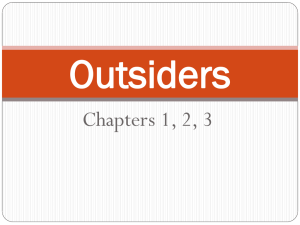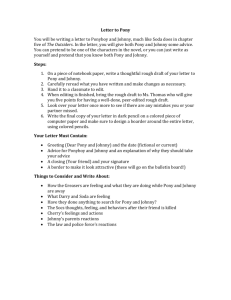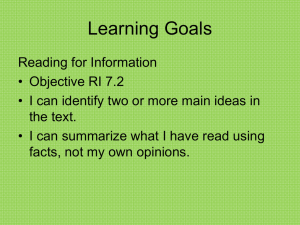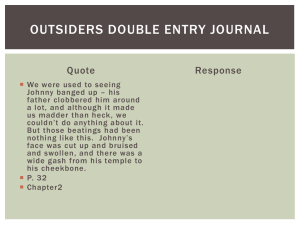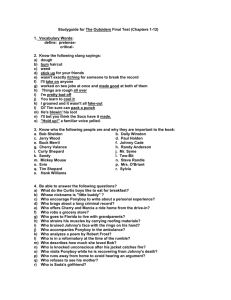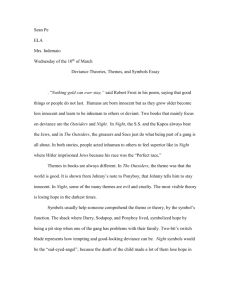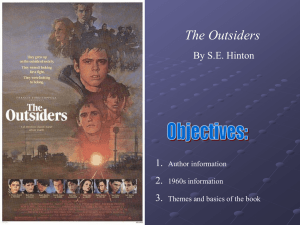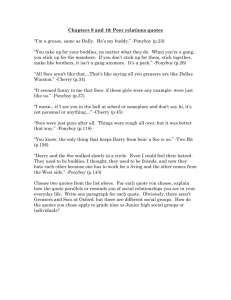"Outside of Nothing: The Place of Community in
advertisement
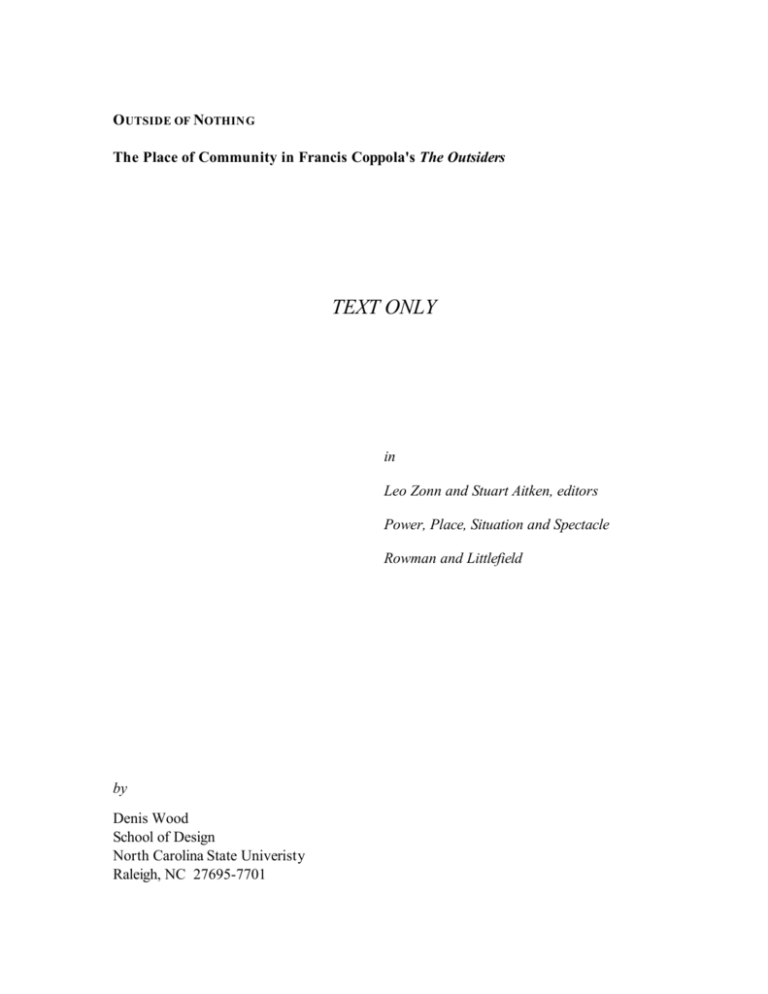
O UTSIDE OF NOTHING The Place of Community in Francis Coppola's The Outsiders TEXT ONLY in Leo Zonn and Stuart Aitken, editors Power, Place, Situation and Spectacle Rowman and Littlefield by Denis Wood School of Design North Carolina State Univeristy Raleigh, NC 27695-7701 2 On the corner of the street he lived on, hung out a gang of Puerto Rican lads. One of them came with a shining new bicycle and all were soon wildly pedalling it. Jeremy was charmed by this generous camaraderie, as if all property belonged to all. But he quickly saw that there was no community, no mutual pleasure or mutual concern, but each one was simply proving his prowess and demanding an equal go in order not to be belittled. All were so fearful of everything that they could not afford to be affectionate to anyone. Paul Goodman When, many years ago, I srtepped out into the bright sunlight from the darkness of the movie house, I had only one thing on my mind: what to make of Francis Coppola's The Outsiders.71 I've been thinking about it off and on ever since. The woman I was with hadn't liked it -- teenage kids don't run away like that, she said. That didn't bother me so much: enough do. And besides, it was a film that seemed to me to go out of its way to make sure you didn't mistake it for a documentary or for a gang film or for anything else. I kept thinking about the Gone With the Wind quality of the color and the light when Ponyboy recited the Robert Frost poem and the way the camera dollied and panned in one of the scenes just after the credits, about the way the camera rotated just after the murder, and about the way the film never fooled around with my emotions when Johnny and Dallas died, about the Caravaggesque feeling to the close shots around the fire, about those close-ups, those huge close-ups ... It struck me as a film that insisted on being taken on its own grounds for itself, and what was bothering me was that I wasn't sure what those were. 1The Outsiders was based on the novel of the same name by S. E. Hinton and the screenplay based thereon by Kathleen Knutsen Rowell. It was produced by Fred Roos and Gary Frederickson and directed by Francis Coppola for Warner Brothers for release in 1982. It didn't, however, make the theaters until the spring of 1983. 3 Everything about the film put me off -- the S. E. Hinton novel on which it was based ("An Heroic Story of Youth and Belonging -- Over Four Million Copies in Print"2), the pretty-boy stars from the pages of 16, Tiger Beat and Superteen ("Matt Shares His Private Thoughts With You!"3), the Stevie Wonder ballad, the lush Carmine Coppola score, the movieland gossip ("Will Coppola soon be in the market for another studio?"4) -even as it attracted me. Exactly like the teenagers it's about. They have a tough, cocky self-sufficient style that warns one off, threatens one, denies the possibility of human intimacy, even as its transparent fragility and reactionary superficiality indicate its vulnerability and proclaim a yearning for community. Later I was to understand that by making itself in its subjects' image the film put itselt precisely in their precarious situation, mirroring deeply its content in its form, for its ultimate subjects are all of us who do not resist the cleavage between form and content, ends and means. But I didn't understand this at first, because I confronting rather than penetrating its style and that, as the film makes clear, leads only to a stand-off. The film permits few passive viewers. In order to see through the film it is necessary to see the film, not as a collection of parts, but as a superordinate emergent intelligence, in which context alone the parts make sense. Needless to say, this whole is embodied in its parts, but none of these fails to refer outside itself, not just to other parts, but toward the whole, toward The Outsiders and towards its makers' intentions. This filmic, as differentiated from scenic, self-consciousness is manifested in an apparent tension between what is on the screen and the way it is there -- a tension resolved only within the frame of the film as a whole. As experienced, however, scene by scene, this resolution is continuously elusive, provoking endless reiterations of "What am I to make of this?" In answering these questions one inevtiably chooses whether to be merely entertained by the film or to engage it in dialogue. This provocation is present from the opening shot. Seated at a desk a neat, blond, teenage boy bathed in an aureate light is caught in medium close-up staring off into the 2S. E. Hinton, The Outsiders, Viking Press: New York, 1967. The sales figures are from the cover of the paperback released to coincide with the release of the film. 3The remark is from the cover, Superteen, July, 1982. No teenage oriented magazine of the period failed to carry stories about the film and its stars. 4"The Outsiders," American Film, October 1982, p. 77. This is an unsigned paragraph from a section called "Trailers." It's probably relevant to recall that Coppola had just bombed disastrously with the over-budget One From the Heart, was entangled in the production of Hammett, and was losing/had lost Zoetrope Studios in the process. The Outsiders had, in many senses, to be a comeback film for Coppola. 4 deep space of contemplation. The camera slowly pulls in on the boy's face (which comes to fill half the Panavision frame) before looking down. Adopting the boy's point of view, the camera watches his hand laboriously pen the words (simultaneously recited on the soundtrack), "When I stepped out into the bright sunlight ... " into a school composition notebook. Both visual and sound tracks fade into the titles, Stevie Wonder singing "Stay Gold" over gilded clouds hovering around a golden sun, setting in a sky the red of all remembered sunsets. The implausibly golden light and patent innocence -- almost vacuity -- of the young face and carefully arranged hair drives the portentiousness of the camera's slow movement into the close-up in the direction of ... what? Pretentiousness? Sentimentality? But the inclination to snicker is suspended by a concurrent sense of simple and serious purpose. The boy is not camping it up. Neither is the camera. Yet ... it is so stylized. What is one to make of it? The title only exacerbates the problem. Over Stevie Wonder and romantically dissolving shots of a medium-sized town suffused with the light of the setting sun, the words T HE O UTSIDERS is a classic seriffed typeface nearly the full height of the screen take their own sweet time scrolling monumentally across it. The cast credits, Greasers on the right, Socs on the left, are each laid down, before zooming, in turn, to full frame and scrolling up the screen. It's a piece of technical flash thrown away, as often in this film, as if its makers felt compelled to assure us they knew what they were doing. Again, any inclinations to discount the film are held in abeyance. Predispositions to find sappy the dissolving sunset scenery are forced to contend with the classicism of the typeface, the pace and flash of the credits.5 These are subtle enough contradictions, and it is not clear that most audiences could articulate them. Yet no one I have talked to has proven immune to their effects. "At first I couldn't decide how to take it," they say, and they acknowledge little help from the scenes that follow. Three boys meet on a street corner. You think you recognize them immediately, the sleeves cut off the sweatshirt at the armholes, the denim jacket flapping 5Not irrelevant here are Roland Barthes' observations about some of the ways bourgeois society attempts a kind of naturalism: "Generally, however, our society takes the greatest pains to conjure away the coding of the narrative situation: there is no counting the number of narational devices which seek to naturalize the subsequent narrative by feigning to make it the outcome of some natural circumstance and thus, as it were, 'disinaugurating' it: epistolary novels, supposedly rediscovered manuscripts, author who met the narrator, films which begin the story before the credits. The reluctance to declare its codes characterizes bourgeois society and the mass culture issuing from it: both demand signs which do not look like signs" (Roland Barthes, "Introduction to the Structural Analysis of Narratives," Image-Music-Text, Hill and Wang: New York, 1977, p. 116). 5 in the breeze, the collar turned up on the black leather jacket. They're street corner punks, Dead End kids. "What's happening, Dallas?" one asks. "We're early." "What do you want to do?" "Nothing legal ... let's get out of here," and they slouch off down the street with insouciant grace. Killing time. The camera tracks with them as they glide left across the screen toward a drive-in diner, moves with them as they array themselves around a car to talk with the greasers inside.A fight starts near them -- as stylized as a ballet. The boys move, circling right across the screen, the camera, crouched, dollying and panning. In the fight a knife snaps open. The three boys continue their ciruclar movement around the fight. Against their motion a crusier pulls into the lot, the cop, also pulling against their motion, drawing his nightstick as he gets out of the car. It's such a fluid scene, currents and counter-currents, choreographed icons of low teenage life. The icons are so pat, but the camera's so fresh! The boys shamble into a gas station, hassle friends, get money, head on. They swagger down a street. "What's the movie about, Dallas?" "I don't know, it's one of those beach movies, they made a lot of them," says Dallas (Matt Dillon), grabbing the other's head with his right arm, bopping it with his left. They look into a store window, shielding the glass against the glare with cupped hands. They're moving, burning calories, getting-out-of-here wherever they are. Punk ... but okay kids. You can tell. Three younger kids kneeling in the grass with playing cards occupy the right-hand side of the screen. The three older boys saunter through a hole in the fence in the background. "Did I say you could use my grass?" asks Dallas. The kids, terrified, shake their heads. Dallas demands the cards, interprets some gesture as a wisecrack. His friends stand awkwardly behind him. "I don't like little kids ... I ... just don't like them." His profiled face fills the screen and it's obvious he's not kidding. He throws the cards into the air, chases the little kids across the grass, long and golden-green in the low sunlight. Panting, the three lurch large into the frame, bobbing and weaving like kids who don't run for the hell of it. Idyllic violence. Terrifying humor. They're not nice, these kids. They've hearts of ... what? Gold? Or stone? "It's getting dark enough," Dallas says, and they crawl under a fence and into a drive-in movie. The whole sequence doesn't take five minutes, but the camera set-ups have been inspired, the superficial simplicity of the action masks a breath-taking complexity, and the acting is so refined that it seems, well, natural. In fact, the whole thing has the effortless grace of one of those endlessly rehearsed dances of Fred Astaire and Ginger Rogers, "Isn't This a Lovely Day?" from Top Hat perhaps, though what sticks in the mind about what follows are the references to, and parallels with, the work of Caravaggio, not just because most of his early sitters were adolescent boys indistinguishable from these, but because 6 the film takes on an increasingly Caravaggesque tone as it unfolds.6 Among the scenes in the drive-in sequence are some that strike me as direct quotations. The mellow chiaroscuro and tight framing of Dallas, Cherry (Diane Lane), Ponyboy (C. Thomas Howell), Marcia (Michelle Meyrink) and Johnny (Ralph Macchio), for instance, is more than an echo of the Metropolitan's Music Party;7 while the subsequent fire-lit scene in the lot is later Caravaggio sieved to an attitude: the highly dramatic chiaroscuro, the shallow picture plane, the heightened emotional tension, and the deliberate casualness of Ponyboy and Johnny embracing are all hallmarks of Caravaggio's style. It is no surprise that it is this scene that most disturbs viewers, forcing them finally to cease asking, "What am I to make of this?" and come to some decision.8 Johnny and Ponyboy, the two young greasers palling around with Dallas in the opening vignettes, and their friend Two-Bit (Emilio Estevez) have picked up -- or been picked up by -- two somewhat older girls from the right side of the tracks (Socs, which short for Socials rhymes with gauches). This unexpected idyll has been shattered by an unpleasant encounter with the girls' boyfriends and later by a drunken brawl between Johnny's mother and father. Pony and Johnny have fled to an empty lot where they have built a fire whose light plays on close-ups of their faces, completely filing the screen. Johnny's head leans on Pony's shoulder, but both their minds are elsewhere. When Johnny reveals the surface of his thought with, "Man, that was a tuff car. Mustang's are tuff," Ponyboy abruptly moves to the fire, returning to comfort Johnny only when he 6Reacting against both the idealism and mannerism of the 16th century, Michelangelo Caravaggio introduced both a revolutionary naturalism and dramatic realism, the latter typified by a shallow picture plane and a startling chiaroscuro. See Walter Friedländer, Caravaggio Studies, Princeton University Press: Princeton, 1955; and the essays and plates in the catalogue, The Age of Caravaggio, Metropolitan Museum of Art, New York, 1985. 7 See Mina Gregori's entry for The Musicians in the Metropolitan catalogue, op. cit., p. 228-235, as well as the beautiful reproduction on p. 230. 8There are really two issues here. One revolves around the fact that The Outsiders was, to begin with, a teen flick. How seriously was one to take it? Many critics dismissed it out of hand, on this ground alone. Godfrey Cheshire, for example, complained that "from telling morally complex tales for adults, Coppola has regressed -- that's the only word for it -- to the level of the Hardy Boys" ((Godfrey Cheshire, "New and Noteworthy," The Spectator, April 14, 1983, p. 16). But as frequently as not, this was prompted by an uneasiness over the homosexual implications of what Cheshire glossed as "pretty teenage boys gazing sensitively and spouting poetry at each other." What was it? Homoeroticism on the big screen? Pin-ups for teenage girls? A stupid teen flick? Or was it, as the evident craft and intelligence of the movie-making and script insisted, something else altogether? 7 speaks of killing himself. "Don't -- you can't kill yourself, Johnny." "Well, I won't. But I gotta do something. It seems like there's gotta be someplace without greasers or socs, with just people ... " They lean back against an old car seat and look up at the stars. The camera slowly moves in on their faces, closing in on Ponyboy -- on C. Thomas Howell, on a boy -- so unrelentingly that the whole screen comes to be occupied by only a part of his face, his right eye dead center. The viewer has no choice but to come to terms with these faces on which the film is lavishing such meticulous attention, both in themselves and as metonyms for the very subject of low teenage life. The carefully asymmetrcial composition, the Caravaggesque lighting caressing nothing but their skin, insist on the intrinsic value and beauty of these teenage boys -- something as difficult to insist upon in Coppola's 20th century as in Caravaggio's 17th, when the unquenchable beauty of the boy in the Berlin Amor Victoris, then in the collection of the Marchese Giustiniani, was discreetly veiled by a green curtain.9 Nothing so bold as Caravaggio's puer lascivus is essayed in The Outsiders. As a boy in the audience at a $2 matinee shouted when the girls packing the house began to squeal at the spectacle of a BVD-clad Matt Dillon bouncing around on his hospital bed, "Don't worry, girls, you won't see nothinbg!"10). In any case, neither Hinton's nor Coppola's interest is even marginally focused on the triumphs of any kind of love, but rather on a more elusive ... failure of community. So what are these faces, 9There seems to be little middle ground in our thinking about the display of nude teenage males. Here, for example, is Michael Jacobs on the Amor Victoris (or Amor Vincit Omnia): "Another artist with a line of blatant 'pin-ups' was Caravaggio, but his sexual inclinations, like those of his clientele, were exclusively homosexual. The male nude in art, usually athletic and well-developed, seems absurd as simply a languorous object of passive sensual contemplation. Exceptions are the bodies of young boys, which served as subjects for many of Caravaggio's early paintings, destined for such notorious paedophiliacs as Cardinal del Monte and Vinccenzo Giustiniani" et cetera et cetera (Michael Jacobs, Nude Painting, Mayflower Books: New York, 1979, pp. 45-49). For another reading, all but ignoring (or denying) the homosexual implications of the painting, and stressing instead the way it illustrates the Vergilian "Omnia vincit amor, tu pictor, et omnia vincis,/Scilicet ille animos, corpora tuque animos," see Mina Gregori's essay in the Metropolitan catalogue, op. cit., pp. 277-281, which also provides a history of the painting's shifting interpretations. 10Here's Godfrey Cheshire on this scene: "Clad in his BVDs, Dillon is made to move around the bed unnecessarily but relentlessly, showing us his glorious pubescent physique from every angle; in one emphatic composition, the boy lies prone and the camera cuts off his face at mid-forehead, so that screen-center is dominated by his statuesque torso. What, one inevitably wonders, is going here?" But had it been a girl cavorting on the bed, would Cheshire have even raised the question? 8 these bodies, that even had reviewers defending Coppola's heterosexuality? Means run amok? Uncontrolable sentimentality? Sops to the market that month after month lays down a couple of dollars apiece for Teen Bag -- "Color Pin-Ups" -- 16 -- "Glorious Color Pin-Ups" -- or Superteen -- "18 Eye-Popping Color Pinups" (including "Yummy Matt Dillon" and "Dynamite Bob Lowe, " the latter of whom plays Sodapop, Pony's older brother in the film)? None of these. On the contrary, they happen to be nothing less than the cinematic, nay, filmic -- even using the word in the strict sense of Barthes' "third meaning" -figuration of the Hinton novel taken as a whole.11 In the world of The Outsiders, where social roles maim and finally even kill, the only good body, the only sane, healthy body, is the body unadorned, unstigmatized, unalienated, meaningless, free ... And Ponyboy, whose skin lies so large on the theater wall, is the only one who has one. The temptation is powerful to take Ponyboy as the epitomical outsider, pure body because, standing outside (he has no parents, he is not a Soc, he's too young to drink), he has no place within. And clearly this is how most viewers chose to read the film (the title is The Outsiders and these are the guys the film's about, so these guys must be the outsiders). Given such a reading, the close-ups of Pony and Johnny are patronizing at worst, sentimental at best. But to be an outsider is to stand outside something, and when that something does not exist everyone is an outsider. In The Outsiders this something is community, and its signal absence in the recognizable world of this film suggests that everyone is an outsider, we no less than the characters in the film. In such a world everyone seeks community where he cannot find it, in small groups incapable of coalescing into anything larger, clinging to such group membership the more tenaciously as there is no perceptible alternative. Everyone is trapped outside their own humanity by allegiance to signs of membership in these groups substantially less than the human whole ... which frustrates the possibility of the human whole emerging. Eventually signs of 11Barthes introduced the notion of the third (or obtuse) meaning in "The Third Meaning: Research notes on some Eisenstein stills" (Image-Music-Text, op. cit., pp. 69-78), where it is distinguished from informational and symbolic (or obvious) meanings. The third meaning is that which ... lies beyond, which works apart from the narrative without destroying it, which lends itself to a ... vertical reading. With respect to the cinema he writes, "In other words, the third meaning structures the film differently without subverting the story and for this reason, perhaps, it is at the level of the third meaning, and at that level alone, that the 'filmic' finally merges. The filmic is that in the film which cannot be described, the representation which cannot be represented. The filmic begins only where language and metalanguage end." And this is significance of these boys ... about which ... I cannot write. 9 identitty themselves come to acquire greater significance than anything they might have stood for, and the ensuing confusion of means with ends leads to the tragic spectacle of people hungry for community ripping it apart in the attempt to defend no more than phantom visions of its existence. The tissues and organs of our body lose not only their role but their very being when our body dies. In The Outsiders the body of the community is dead (or has never come to life), and that community cannot be found in any of its parts (Socs or greasers) alone. The film's point is not, as some have had it, that everybody dies, but that nobody lives, at least not with anybody else.12 It is common to use the word "community" in two senses. The first of these makes reference to a group of people with some common identity of fellowship characterized by mutual aid, concern and pleasure. The second makes reference, in an increasingly general way, to the location of that community. The former is a bunch of human beings who care for each other; the latter a geographical entity like a neighborhood, town or city. Because we have created organizations that enable the functioning of these geographical entities in the absence of any sense of fellowship, and because we use one word to describe two different things, we have a predisposition to take community for granted. Because many things -- like the telephone -- seem to work with unfailing precision; and the buses run on time; and the hospitals are stocked with blood; we accept that we have a community and so make no effort to achieve one. The "community" chest is full and the "community" college over-enrolled and the volunteer fire department never fails to put out the fire. In The Outsiders this "community" is taken absolutely for granted. There is no question about the electric company providing the energy that lets Pony, Johnny and Dallas watch Beach Blanket Bingo at the drive-in. Darry (Patrick Swayze) and Dallas use the telephone as casually as another limb. The freight train that takes Pony and Johnny to Windrixville is the 3:15 and there is no question of its not being on time. There is no surprise about the ambulance that takes Pony, Johnny and Dallas to the hospital, nor doubt about their being admitted and well cared for, despite their vagrant status and patent lack of Blue Cross cards. Pony and Two-Bit don't fret about the bus that takes them home being late or unreliable. Schools and jobs -- like Darry's, Sodapop's and Steve's (Tom Cruise) -- are simple givens. Convenience stores are open all night. The firemen and police are on the job. Supposedly set -- and actually shot -- in Tulsa, this point is not made in the film (or for that matter the Hinton novel). The name of a factory in the background of a shot four-fifths of the way through the film does contain the word 12That everyone dies is the moral drawn by Richard Corliss, "Playing Tough, Going Nowhere," Time, April 4, 1983, p. 78. 10 "Oklahoma," and the test-pattern of a TV in the corner of a frame even later in the movie does say "Tulsa," but most of the references in the Hinton novel to horses have been dropped, and the city, the region, don't really matter. Neither does the era. Supposedly set in 1966, coffee's pretty cheap and the cars aren't this year's models, but if the film isn't set in the galloping all-consuming present, it's not a costume picture either. The action does unfold in a real gritty and coherent place and time, but it's anyplace and anytime, any medium-sized contemporary town, it is America. Anonymous and faceless. In the convenience store that is open all night the owner calls the youth of his town punks. And the kids do fight, do kill each other. There are no parents to see their kids to bed: Johnny's brawl, Pony's are actually dead, Dallas lives with friends. In the hospital where Dallas and Johnny are taken only their bodies are addressed. In the end the cops kill Dallas. There is little community in this "community" built of Socs and greasers. On the South Side the Socs have it made. They are the cheerleaders and the lettermen and they drive Mustangs and drink whiskey out of flasks. They wear their pants as short as their crew-cut hair. The greasers live on the North Side and they don't have it made and they never will. They are the dropouts who end up pumping gas and they walk and drink beer and smoke unfiltered Camels. They wear their blue jeans as long as their pomaded and carefully sculpted hair. The social world of the Hinton novel is marginally more complex. There, a middle-class stands between the Socs and the greasers, themselves a cut above a subclass of hoods. Of Dallas, for instance, Hinton writes that "the shade of difference that separates a greaser from a hood wasn't present ... He was as wild as the boys in the downtown outfits, like Tim Shepard's gang."13 Coppola largely ignores these complications, creating for his anytown a strippeddown social environment exactly as a physicist specifies the conditions of an ideal gas, or a geographer postulates a homogeneous and infinitely extended plane on which to model the development of urban systems. Just as these scientists are thereby enabled to speak of the behavior of any molecule or any city, so Coppola would seem enabled to refer to any group of people. The Outsiders thus seems to assume the explicit intentions of its narrator (Ponyboy) and the novel's author to take on the character of a morality play in which Socs and greasers are to be accepted as any pair of mutually exclusive groups. The behavior of the Socs is not well limned in The Outsiders, but -- except with respect to the signs they exhibit to evince the fact that they are indubitably Socs -- there is every reason to believe it is similar to that of the greasers on whom the film is centered. This is not the case, again, with the Hinton novel, in which Socs gratuitously assault the 13Hinton, op. cit., p. 19. 11 greasers in a manner which is not reciprocated. Though he shot such scenes -- in fact the whole book page by page -- in the film as released Coppola drops them.14 In abolishing this behavioral distinction, the action of the film is constrained to evolve out of no agent specific to either group, but out of their failure of community alone. Some pains are taken to establish the similarity of the two groups in this respect. It is the aggressive shoving of the chubby greaser in the line at the drive-in concession stand that precipitates the tiff that follows, but it is Dallas's crude and insulting attempt to pick up Cherry that precipitates, ultimately, the Soc attack on Johnny and Ponyboy. It is this attack that causes Johnny to kill Bob Sheldon (Leif Garrett) and this murder that leads to the rumble. There Socs and greasers are perfectly matched, from the face-off of Darry and Paul to each of the carefully choreographed kicks and punches. When, in Ponyboy's description of a Soc attack on Johnny, Cherry hears an implication that all Socs are like that, she retaliates with a description of generally similar behavior on the part of Dallas; in counterpoint, Pony assures Cherry that one can see the sun set equally well from north and south sides of town. Repudiation of Soc-greaser tension similarly comes with equal force from both sides, as Johnny's early plea for a world without Socs and greasers is echoed faintly in Randy's (Darren Dalton) monologue to Pony; and Randy's insistence that fighting solves nothing is repeated in Johnny's dying words to Dallas. Identical in their behavior, equally (if incompletely) convinced of its inanity, Socs and greasers nonetheless persevere in it, because all are so afraid of being nobody and so incapable of being somebody on their own that they are forced to hew to the identities vouchsafed them by the "communities" of their fellows, where identity derives not from being somebody, but merely from not being somebody else, Soc merely not greaser, greaser merely not Soc. They are, then, communities of signs, not substance, redoubts against the world, not propositions for its forging. This is not to say the superficial camaraderie that Jeremy -- in the epigram -- sees in the Puerto Rican lads hanging out on his street is absent. Far 14But why? It was not, probably, to achieve the thematic intelligence I think the loss of these scenes gives the film. Apparently Warners found the film too violent for the audience of young teen girls it assumed would comprise its major audience and they requested and got another cut. This did not necessarily make everybody happy. Rob Lowe, for example, was all but cut from the film: "It's difficult for me to watch that movie. The only reason I watch it is to see the other people in it. I can't watch it to see myself because I'm not in it. We just bastardized that book. A lot of irate young kids have come up to me and asked what happened to the movie. I hope the people responsible for the way it turned out get the same complaints I do" (Stephen Farber, "Rob Lowe," Moviegoer, September, 1984, p. 18). 12 from it. It is present in such touching abundance -- especially among the greasers -- that it has moved Richard Corliss to describe it as "familial, embracing and unselfconsciously homoerotic," though he failed to add that it is also superficial, reactionary and fatally incomplete.15 The film permits no doubt about either of these points. The camaraderie is everywhere, in mutual association, mutual affection and mutual aid. Ponyboy, for instance, from whose point of view the film is largely shot, is alone only in the framing shots that open and conclude the film. He is always palling around with someone, Johnny, Two-Bit, Dallas or his brothers, who are themselves always palling around with others, Sodapop with Steve or Darry, Steve with Two-Bit, or all of them together (around the gas pumps, at breakfast, before, during and after the rumble). Their affection for each other, openly expressed only between Pony and Johnny and among the brothers in their reconciliation in the hospital, is otherwise exhibited by constant touching (as when Dallas takes Johnny's head under his right arm and bops it with his left), arm-wrestling (as between Steve and Sodapop) and taunting banter. I count no less than twenty-eight instances of mutual aid in the film, from Pony helping Johnny climb under the fence into the drive-in, through the constant sharing of food, clothing and cigarettes (property might as well be communal), to Johnny's willingness to kill in defense of Pony. But neither Hinton nor Coppola make too much of this, and far from idealizing it, reveal it as ultimately empty, an inadequate substitute for the real thing. Take one of the most beautifully put together scenes in the film, Pony's reintegration into this community of comrades after his flight from the law. Pony is frying eggs when Steve and Two-Bit enter his house as freely as though they lived there, which in a sense they do. Glad to see Pony after his absence, they roughhouse him, causing him throw the eggs on the walls and the floor. Kidding him about his short bleached hair and his new hero's status, they casually pull a beer from the refrigerator and a chocolate cake from a shelf. Darry emerges in response to a jibe from Steve, and Sodapop pops out of the bathroom draped in a towel. Steve reminds him to put on his pants (" ... there's a law or something ... ") and latter to get his shoes. Two-Bit watches Mickey Mouse on television, across which Pony and Darry hold a stuttering conversation about their future as a family and whether Darry should leave Pony home alone, before Darry, Steve and Soda dribble off to work, leaving Two-Bit to care for convalescent the Pony. Granting that this incredibly fluid piece of filmmaking manifests friendly familiarity, there is 15Richard Corliss, op. cit. Though he found the film "not quite a good one," he liked it better than just about anyone else reviewing it at the time (anybody, that is, who wasn't writing for one of the teen magazines). 13 nothing terribly positive about it. It is not just -- or even especially -- that in welcoming him home, Steve and Two-Bit cause him to throw away the eggs he's been cooking, nor that they don't bother to help clean up the mess, but that they are incapable of saying, "Welcome Home!" in a direct and supportive manner (everything is so heavily coded they can't speak straight), incapable of recognizing that Darry and Pony have important things to say to each other (in a world where nothing matters ... nothing matters), incapable of aiding Pony in his recovery (especialy whenever it would violate anything coded ... cool). Worse, Two-Bit violates Darry's explicit instructions to keep Pony at home, and all conspire in permitting him to join the rumble that leads to his nervous breakdown. But all their behavior involving each other is like this, from the least action (the "playful" hurts required to manifest affection) to the most global (the failure of family that leads Pony to run away, the compulsive violence of the "rumbles," the cheapness with which life is held). Evidently, then, the camaraderie is superficial and the "communities" of Socs and greasers merely signatory. But if nothing but signs keeps them apart, and if being at odds is so destructive, why cannot Socs and greasers, in the great tradition of American liberalism, get over their differences and get together on what they share in common? Clearly this is what Pony and Cherry and Johnny and Randy are on about with their observations on sunsets and their comments on the futility of fighting. Why doesn't it work? Why doesn't Coppola conclude his film with Socs and greasers pulling together to ... clean up the environment? Because even signs must be embodied. Since signs necessarily weld a signified to a signifier, and since the latter is unavoidably substantial, the sign -- at least as an expressive pertinence -- is unavoidably substantial as well.16 It is here that Coppola's Caravaggesque gloss has to be taken for the materialist polemic it is. Precisely because his camera has insisted upon the fleshy reality of the boys it caresses, it forecloses the possibility of them being no more than cards in a game of social poker. Endowed by the camera's scrutiny with an inescapable naturalism (the naturalism of the bug beneath the entomologist's lens), their bodies are thereby 16Strictly speaking, the "sign is not a physical entity, the physical entity being at most the concrete occurence of the expressive pertinent element" (Umberto Eco, A Theory of Semiotics, Indiana University Press: Bloomington, 1976, p. 49). See also Ferdinand de Saussure, Course in General Linguistics, The Philosophical Library: New York, 1959, especially pages 65-78; Roland Barthes, Elements of Semiology, Hill and Wang: New York, 1968; and Jonathan Cullers, The Pursuit of Signs, Cornell University Press: Ithaca, 1981. 14 granted the dignity of the history that produced them.17 Coppola's gaze does not universalize, it particularizes them, it grants them the uniqueness of their situation in time and space, a situation scarred by the no less observable sociospatial realities of an American class system. With their short hair the Soc boys get the cars the greasers with their longer hair make do without. With their madras jackets come the good-looking girls that the leather jackets seem unable to attract. With the whiskey come the big houses on the South Side of town. In the refrigerators of the shacks in the North there's only beer. The differences between Socs and greasers are superficial -- they do constitute a sign system -- but in Coppola's hands they are signs that point to substantial, material, historical differences as surely as topographic differences on the surface of the earth point toward differences at the core-mantle boundary. To embed these differences as deeply in his film as he could, Coppola attempted to replicate in his young cast off-stage the differences Hinton had described for her hometown: "Coppola wanted to create a tension between the Socs and the greasers even off the set," reported Leif Garrett. "He did this by paying more per-diem to the Socs. He also gave better covered scripts to the Socs. He even made sure that their hotel rooms were better than the greasers's. This really made us into rival gangs."18 Darren Dalton remarked the spatial dimension when he noted that "greasers and Socs didn't mix even off the set."19 Lacking any sense of real community, too materially different to regard each 17As Barthes writes, "I then realized with stupefaction (only the obvious can stupefy) that my own body was historical." The realization is described in his, "Inaugural Lecture, Collège de France," A Barthes Reader, Hill and Wang: New York, 1982, p. 478. This historicity of the body -- its historically created particularity -- is, since it cuts against the ideal, precisely what fueled Caravaggio's naturalism and scandalized his contemporaries, notoriously in hia Death of the Virgin (see the discussion in Mina Gregori's "Caravaggio Today," in the Metropolitan catalogue, op. cit., p. 43). 18Howard Weiss, "Interview with Leif Garret," An Inside Look At All the Stars of The Outsiders: Superteen Special No. 6, p. 33. In an interview, Rob Lowe -- a greaser -- added that "They were on one floor of the hotel and got their beds turned down at night while we were on another where Francis had forbidden the maids to touch the beds. They went to live for a while with Tulsa oil families while we spent time with people who had been greasers in the mid-Sixties. They did rich kid things while we'd get into wardrobe and hang our at this park and try to carry on convincing conversations with the local kids in our Oklahoma drawls" (Donald Chase, "A New Lowe," Ampersand, April, 1983, p. 10). What is all this but an attempt to create in an actor's body some of the history required by his role? 19Howard Weiss. "Interview with Darren Dalton," ibid., p. 20. Speaking for the greasers, especially C, Thomas Howell and Rob Lowe, Patrick Swayze notes, "While filming this 15 other as no more than variant styles, Socs and greasers are not even "communities" of ... signs -- blue jerseys opposed to white and switch goals at halftime -- but ... kids stirred by history -- that of Tulsa in the fictional world of the film, that engineered by Coppola in the real world of making the movie -- into distinctive melanges locked into mutual loathing by the asymmetry of their situation, an symmetry, it must be insisted upon, generated by the exploitation of greaser parents by Soc parents. By insisting on the material substance of flesh and the history that shapes it, the film's Caravaggesque naturalism propels it beyond the poignant morality tale the sixteen year old Hinton wrote out of the anguish she experienced over the unmotivated beating of a boyfriend of hers.20 Yet the narrative structure her story provides at the same time saved The Outsiders from becoming trapped at the (remarkable) level of documentary achieved by Larry Clark in his contemporaneous Tulsa, a despairing insider's view of teenage speed freaks. If Hinton's suggestion that "because our differences are only skin deep we can be whatever we want to be" is empty, so is Clark's "once the needle goes in it never comes out."21 The elusive truth -- dialectically suspended between dark despair and luminous promise -- is better caught in Coppola's refusal to commit himself either to the story, which the actors would no more than "flesh out," or the body, which the story would no more than justify. Forced to see the story in the body -- in the bodies of these adolescent boys -- we are forced to acknowledge that if the action in the film does evlove out of no more than a failure of community alone, that this failure is not original with these bodies movie, we all got very close ... like brothers. We would play football and just have good times together whenever we had time off which was rare when you are working six days a week. The socs got better treatment than the greasers in order to create a natural tension between us for the film. It worked." (Howard Weiss, "Interview with Patrick Swayze," ibid., p. 27. 20Howard Weiss, "Profile on Susie Hinmton," ibid., p. 47. 21Larry Clark, Tulsa, Larry Clark: New York, 1971. Unpaginated, the quotation appears following the copyright page in this context: "i was born in tulsa oklahoma in 1943. when i was sixteen i started shooting amphetamine. i shot with my friends everyday for three years and then left town but i've gone back through the years. once the needle goes in it never comes out." In American Photography: A Critical History (Abrams: New York, 1984), Jonathan Green describes Tulsa in these words: "Larry Clark's Tulsa shows the quiet atrocities of a very real war. Tulsa is the battlefield. For Clark it was 'shaking' with violence, guns, sex, and drugs, and he was determined 'to get the action.' The needle, the vein, the penis, and the breast were the weapons. The stakes were life and death" (p. 126). Clark's Teenage Lust (Larry Clark, New York, 1983), is even more devastating. It covers Tulsa in the early '70s. 16 but inscribed in them by the sociospatial milieu of which, after all, they are no more than ambulatory incarnations. With their "bodies caught in the toils of parcellized space" to use Henri Lefebvre's words -- the only way out is ... out.22 At the remarkable heart of this film, Pony and Johnny hop the 3:15 to Windrixville where in a sociospatial milieu of neither Soc nor greaser they remake themselves ... as humans. In a world of rabbits, owls and raccoons -Johnny's place "without greasers or Socs" -- they cut and die the hair from which they've washed the eponymous grease. Freed from the taken-for-granted greaser Weltanschauung they not only read to each other from Gone With the Wind, but watch sunsets and recite the poetry of Robert Frost.23 When in response to Pony's complaint that their new looks are,"like being trapped in a Halloween costume you can't get out of", Johnny responds with, "It's our looks or us," the apparent retreat to an ahistorical world of brothers-underthe-skin is blocked by the question their situation begs. After all, in Tulsa their looks were them: why is it here an either-or choice? Because here, as the alert animals and protracted sunsets make evident, they've escaped from the places scarred by history to an Eden of prelapsarian grace (they even live in a deserted -- hence nondenominational -church). Privileged to incarnate here a "natural" world, finally freed of allegiance to signs of membership in any group, their latent humanness is released to let them form a genuine community, that is, one characterized by mutual aid, concern and pleasure. When history does reintrude itself -- as in all but dreams it must -- it is impossible for Pony and Johnny wholly to revert to their original greaser personae. Having been reintegrated into some world -- however marginally -- they try to save the lives of the little kids caught in the burning church to whom they now feel connected. This reimmersion in history, of course, claims, Johnny's life and plunges Pony back again into the "parcellized space" of Soc and greaser. There he will fight in a rumble which will precipitate the death of Dallas and his own nervous breakdown. 22Henri Lefebvre, The Production of Space, Basil Blackwell: Oxford, 1991, p. 98. "Nothing Gold Can Stay," from Robert Frost, Complete Poems of Robert Frost, Holt, Rinehart and Winston: New York, 1951, p. 85. Ponyboy's recitation of this poem to Johnny after watching a sunrise drives critics as nuts as the close-ups of their faces or the shots of Matt Dillon on his hospital bed. Here's Richard Corliss: "Left to their better selves, [the greasers] can easily go all moony over sunsets, quote great swatches of Robert Frost verse, or fall innocently asleep in each other's arms. Their ideal world is both a womb and a locker room: no women need apply to this dreamy brotherhood" (op. cit.). The "great swatches" of verse consist of eight, short, rhymed lines. 23Namely 17 At the end, Pony, bathed in an aureate light, is seated at his desk, his dark hair still dyed blond, inwardly grappling with the reality of Johnny and Dallas's deaths. As he reads Johnny's deathbed letter the camera slowly pulls in on his face. Far from vacuous, it is now suffused with the tragic awareness that in a world parcelled out between Socs who have and greasers who have not, there is no space to escape into to realize the promise of escape Johnny's letter makes, that there can be no community among those who exploit one another, that though we can to some extent make our own history, we cannot do so free of the constraints of the history we embody. Like those who created him (Hinton, Coppola), Ponyboy will cope with this realization by transmuting it into art. After his face -- in which all this is inscribed -- has filled half the screen, the camera adopts his point of view, watching as he laboriously pens the words that open both book and movie: "When I stepped out into the bright sunlight from the darkness of the movie house ... "
